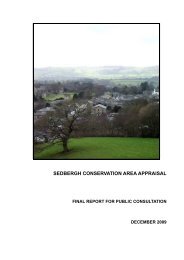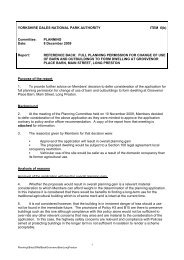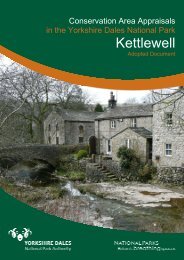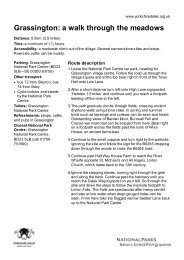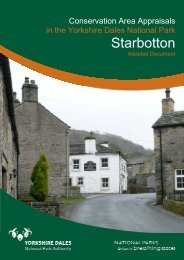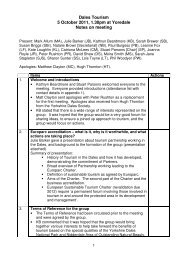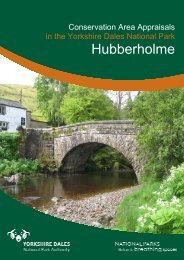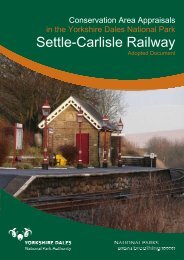Langcliffe - Yorkshire Dales National Park
Langcliffe - Yorkshire Dales National Park
Langcliffe - Yorkshire Dales National Park
- No tags were found...
You also want an ePaper? Increase the reach of your titles
YUMPU automatically turns print PDFs into web optimized ePapers that Google loves.
are not included within the conservation area. There are two listedbuildings along this stretch which are inside the boundary – the keylandmark Mount Pleasant House at the northern end and the fairlyconcealed <strong>Langcliffe</strong> Hall at the southern end of the village; both of themare described in more detail later (see 4.4.c).Figure 06: View alongside theB6479, facing south, with MountPleasant House on the left(photo © Gaby Rose, YDNPA,2009)Further to the north, the steep limestone cliffs of <strong>Langcliffe</strong> Scar (figure07) provide a dramatic backdrop to the picturesque village and fieldsbelow.Figure 07: View onto <strong>Langcliffe</strong>Scar, taken from the B6479towards the north (photo ©Gaby Rose, YDNPA, 2009)Geology. <strong>Langcliffe</strong> parish lies between two ancient fault lines: theMiddle Craven and North Craven Faults. The rocks in this area aremainly Great Scar Limestone and some of the Yoredale Series, whichboth belong to the Lower Carboniferous period. There is also a narrowband of Silurian rocks that extends from just south of Malham Tarn to theRibble valley. The carboniferous limestones provide the main buildingmaterial in the village.The geological history of the parish begins in the Silurian period around420 million years ago. Sedimentary rocks, which comprise sandstonesand siltstones of the Austwick Formation, were once eroded materialtransported by rivers into the sea, where they were deposited. At the endof this period, two continental plates collided and alternating layers ofsandstone and siltstone were crumpled into a tightly folded landscape,and later partly worn down by river action.13



